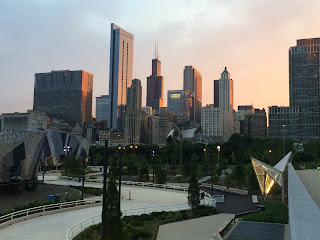 As a music major at Colorado State University in the late 1960s and early 1970s, I was exposed to lots of different music. I liked many things, even though I was not as serious a student as I would have liked. One thing I vividly remember was buying a recording (LP – vinyl) of the Bernstein Mass that had just been performed in 1971 for the opening of the Kennedy Center for Performing Arts in Washington, D.C. I was so captivated by the recording that I sent Leonard Bernstein a personal letter thanking him for the inspiration of the piece and what it meant to me. He responded with a personal and hand-written note, expressing his appreciation for my letter.
As a music major at Colorado State University in the late 1960s and early 1970s, I was exposed to lots of different music. I liked many things, even though I was not as serious a student as I would have liked. One thing I vividly remember was buying a recording (LP – vinyl) of the Bernstein Mass that had just been performed in 1971 for the opening of the Kennedy Center for Performing Arts in Washington, D.C. I was so captivated by the recording that I sent Leonard Bernstein a personal letter thanking him for the inspiration of the piece and what it meant to me. He responded with a personal and hand-written note, expressing his appreciation for my letter.
More than fifty years later, and observing the commemoration of Leonard Bernstein’s 100th birthday on August 25, 2018, it seems as if Lenny and I are old friends; the adulation around the world demonstrates that he was, indeed, a friend to many. We’ve had the extraordinary opportunity to be able to attend the Ravinia Summer Festival where Marin Alsop, Lenny’s last and only female conducting protégé, has curated a series of concerts celebrating Lenny. We’ve heard Marin Alsop conduct Bernstein favorites such as Copland’s Appalachian Spring, Gershwin’s Rhapsody in Blue, Stravinsky’s Rite of Spring, and Beethoven’s Symphony #9, and we’ve heard Alsop interpret Bernstein’s own Chichester Psalms, Symphony #1 (Jeremiah), and the crowning performance of The Mass. The program was carefully constructed to reflect Bernstein’s character, his commitment to innovation, and his undaunted attempts to reach his audiences.
Before the performance of The Mass a panel including Jamie Bernstein (Lenny’s oldest daughter) discussed his life and what inspired The Mass. Jamie’s book, Famous Father Girl: A Memoir of Growing up Bernstein (2018), was available after the panel and I snapped it up as quickly as possible (with autograph). The memoir is partially about Jamie’s life journey in discovering herself as a musician and social activist. The majority of it is an inside look into the very complicated life of a genius who demonstrated deep angst in the jarring and disturbing dissonances and rhythms of his music but always soothed and reassured with the beauty of some of the most soaring melodies of the 20th century.
Born in 1918 to a modest Jewish family in Brooklyn, Lenny married Felicia, a Chilean who came to New York to study piano with Claudio Arrau, in 1951. The marriage would last, although tested by Lenny’s tempestuous and active life until her untimely death in 1978. A considerable portion of Jamie’s memoir recounts Bernstein’s active embraces, slurpy kisses, and effusive responses to men and women alike. Jamie expresses the ambivalence she and her siblings had to the growing realization that their father, endeared and revered, was either bisexual or gay and this ambivalence became even more significant in the latter part of Bernstein’s life when this fact became more public. Life was enthralling and challenging for Felicia and their three children.
Bernstein became an instant sensation in 1946 when he stepped in at age 28 for ailing Bruno Walter to conduct the New York Philharmonic at Carnegie Hall. Not long after his conducting debut, Lenny was recognized for his composing talent in the Broadway hits Fancy Free, On the Town, and West Side Story. Subsequent compositions met with a mixture of praise and criticism. In an effort to reach young people with new music, Bernstein incorporated musical ideas from the Beatles, folk, soul, and other popular artists. Combining these ideas with classical notions and striving to offer accessible and memorable melodies and politically progressive ideas, Bernstein’s music was not easy for others to grasp. The political ideas Bernstein advocated landed him on J. Edgar Hoover’s list of people to be watched; the final file accumulated by the FBI would number 800 pages.
Bernstein died in 1990 and the last words out of his mouth were, “What is this?” What a fitting conclusion to a lifetime of exploring the deeper questions of human existence. I’m not sure why I connected with Bernstein’s Mass in 1971; as a 21 year old at the time, it was a kind of music for which I yearned. Jamie Bernstein’s reflection on why The Mass was criticized when premiered but is now lauded by wide audiences who are hearing it this year is that, “In the new millennium, the world has caught up to Mass. It was, in many ways, ahead of its time. The mixtures of styles, the unapologetic tonality, the urgent questioning of authority, the openhearted political outrage – all these elements freshly resonate today” (p. 137). An artist, a genius, a personality capable of ecstatic joy and desperate sadness, and a failed and yet brilliant leader – Bernstein was a gift to many and his 100th is a wonderful time to reflect on what he gave us.
